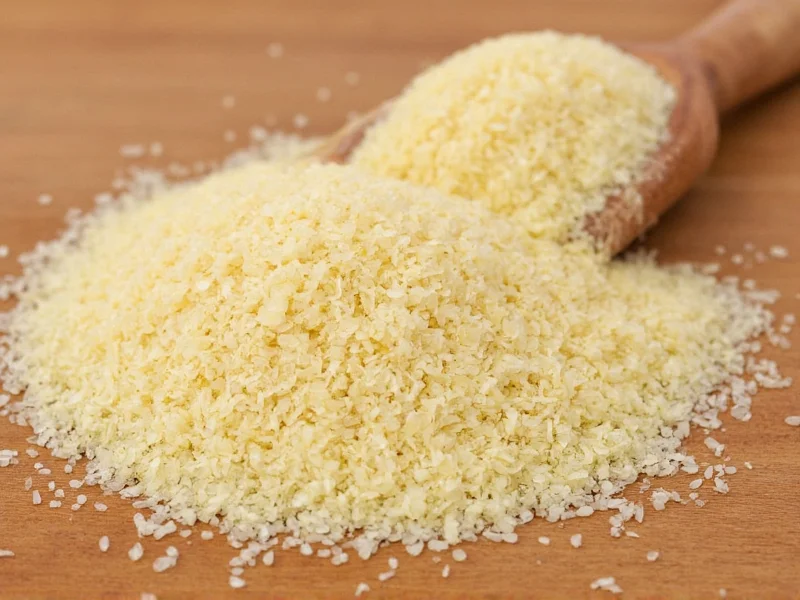Granulated garlic sits between garlic powder and minced garlic in texture—finely ground but not powdery, with moderate moisture content. When your recipe calls for this specific form and you're out of stock, understanding proper substitutions prevents culinary disasters. This guide details precise conversion ratios, flavor impact, and optimal usage scenarios for each alternative.
Understanding Granulated Garlic Characteristics
Granulated garlic consists of dehydrated garlic particles sized between 0.3-0.8mm. Unlike garlic powder (ground to 0.1-0.3mm), it retains some texture while dissolving slower than fresh garlic. Its moderate moisture content (5-8%) creates different dissolution properties in liquids compared to powder (2-4% moisture) or fresh cloves (60-65% moisture). These physical properties directly impact substitution success.
Top 4 Granulated Garlic Substitutes Compared
| Substitute | Conversion Ratio | Flavor Intensity | Best For | Limitations |
|---|---|---|---|---|
| Garlic Powder | 3/4 amount (3:4 ratio) | Stronger (25% more concentrated) | Dry rubs, spice blends, baked goods | Can become bitter if overheated |
| Minced Garlic (jarred) | 2:1 ratio (1/2 tsp per 1/4 tsp granulated) | Milder (diluted by liquid) | Sauces, soups, wet marinades | Adds moisture; adjust liquids accordingly |
| Fresh Garlic | 1 clove = 1/8 tsp granulated | Most complex (raw vs cooked) | Sautés, stir-fries, fresh preparations | Requires mincing; stronger raw flavor |
| Garlic Salt | 1:1 ratio (reduce added salt by 3/4) | Similar (salt enhances perception) | Seasoning blends, savory snacks | High sodium content; not salt-free option |
Detailed Substitution Guidelines
Garlic Powder as Granulated Garlic Replacement
When substituting garlic powder for granulated garlic, use a 3:4 ratio—meaning for every 1 teaspoon of granulated garlic required, use 3/4 teaspoon garlic powder. This accounts for powder's higher surface area and concentration. Garlic powder dissolves faster in liquids but burns more easily in dry heat applications. For roasting or grilling, mix powder with oil first to prevent scorching. This granulated garlic powder substitute works best in spice rubs where quick dissolution matters less.
Using Minced Garlic from a Jar
Preserved minced garlic requires a 2:1 substitution ratio. The liquid medium dilutes flavor intensity while adding moisture to recipes. When replacing granulated garlic with minced garlic in sauces or soups, reduce other liquids by 1-2 teaspoons per substitution to maintain consistency. For baked goods, blot excess moisture from minced garlic with paper towels before incorporating. This granulated garlic substitute measurement prevents sogginess in doughs and batters.
Fresh Garlic Conversion Strategy
One medium garlic clove (about 5g peeled) equals approximately 1/8 teaspoon granulated garlic. Mince fresh garlic finely or press through a garlic press for even distribution. Raw fresh garlic delivers sharper flavor than dehydrated forms—cook 30 seconds longer to mellow the bite. When substituting fresh garlic for granulated garlic in dressings, let the mixture rest 10 minutes to allow flavors to meld. This approach works well for granulated garlic substitute in salad dressing applications where fresh flavor is desirable.
Garlic Salt Considerations
Use equal amounts of garlic salt but reduce additional salt by 75%. For example, if a recipe calls for 1 teaspoon granulated garlic and 1 teaspoon salt, use 1 teaspoon garlic salt plus only 1/4 teaspoon additional salt. This prevents oversalting while maintaining garlic flavor. Ideal for granulated garlic substitute for meat rubs, garlic salt enhances browning through Maillard reactions. Avoid in low-sodium diets or when precise salt control matters.
Advanced Substitution Techniques
For complex dishes requiring layered garlic flavor, combine substitutes strategically. In tomato-based sauces, use 50% fresh garlic (for brightness) and 50% garlic powder (for depth). When substituting granulated garlic in baking, reconstitute powder with 1/4 teaspoon water per teaspoon used to mimic granulated form's moisture content. For granulated garlic substitute in bread recipes, this prevents dry spots while ensuring even flavor distribution.
Temperature affects substitution success. In high-heat applications like stir-frying, fresh garlic provides superior flavor development. For slow-cooked dishes, garlic powder integrates more evenly. Always add garlic substitutes toward the end of cooking for maximum aroma retention—except in braises where early addition builds foundational flavor.
Avoiding Common Substitution Mistakes
Many home cooks make critical errors when replacing granulated garlic. Never substitute equal amounts of garlic powder for granulated—this creates overpowering, potentially bitter results. Avoid using garlic salt in recipes with other salty ingredients like soy sauce or capers without recalculating total sodium. When substituting fresh garlic for granulated garlic in delicate dishes like custards, mince extremely fine to prevent texture issues.
For granulated garlic substitute in canning recipes, maintain proper acidity levels—never increase garlic quantities beyond tested ratios. In fermented foods, remember that fresh garlic introduces different microbial properties than dehydrated forms. Always taste-test before finalizing seasoning when making substitutions.











 浙公网安备
33010002000092号
浙公网安备
33010002000092号 浙B2-20120091-4
浙B2-20120091-4